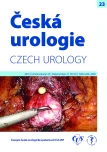Treatment of rectoanastomotic fistulae after laparoscopic radical prostatectomy
Authors:
Květoslav Novák 1; Radim Kočvara 1; Tomáš Hanuš 1; Petr Macek 1; Oldřich Paul 2; David Michalský 2
Authors‘ workplace:
Urologická klinika VFN a 1. LF UK, Praha
1; 1. chirurgická klinika VFN a 1. LF UK, Praha
2
Published in:
Ces Urol 2019; 23(2): 124-130
Category:
Original Articles
Overview
Aim: Rectoanastomotic fistula after laparoscopic radical prostatectomy (LRP) is an infrequent but serious complication. A bowel diversion above the fistula (sigmoidostomy) is needed just like urinary diversion (permanent urethral catheter and epicystostomy 15CH). This is the only chance for spontaneous closure of the fistula but surgical occlusion is more frequent.
Material a methods: From 2008 to 2018 we diagnosed rectoanastomotic fistula in 5 patients from 688 after LRP (0,72 %). Fistula appeared from the 6th to 14th day postoperatively. Diagnosis was confirmed either with cystography or urethrocystography. Immediate both urinary diversions with permanent catheter and epicystostomy (15CH) were inserted and sigmoidostomy was performed as soon as possible (day 1–5).
Results: Spontaneous closure occurred in 2 patients (40 %). In 3 (60 %) definitive occlusion perineally was needed (the 154th, 270th and 383th day). It was a challenging operation in all – operation time varied from 365 min to 425 min. During the healing period the following complications lead to a long interval to definitive fistula clousure: - previous endoscopic extraction of Hem-o-lok clip from fistula in 1, - proximal urethra marsupialization and bulbar urethral resection in a patient with development of severe stricture during the period when the only bladder diversion was epicystostomy. Definitive fistula repair was followed by closure of the sigmodostomy in an interval of 2– months. All patients are without fistula and continent (0–1 pad daily) after follow-up 1–8 year.
Conclusion: Rectoanastomotic fistula after LRP is serious complication where early urinary and bowel diversion is needed. Under these conditions spontaneous healing is possible. Perineal surgical closure is a challenging and time consuming operation but leads to definitive resolution of this complication.
Keywords:
Laparoscopic radical prostatectomy – rectoanastomotic fistula.
Sources
1. Nicita G, Villari D, Grisanti SC, et al. Minimally invasive transanal repair of rectourethral fistulas. Eur Urol 2017; 71: 133–138.
2. Amato A, Pellino G, Secondo P, Selvaggi F. Intersphincteris approach for rectourethral fistulas following radical prostaectomy Tech Coloproctol 2015; 19: 699–703.
3. Thomas CH, Jones J, Jager W, et al. Incidence, Clinical symptoms and management od rectourethral fistulas after radical prostatectomy. J Urol 2010; 183: 608–612.
4. Öbidniak V, Popov S, Orlov I, Kulikov A, Malevich S. Nonoperative management of acquired rectourethral fistula: The modern approach. Eur Urol Suppl 2018; 17(14): e 2902
5. Mandel P, Linnemanstons A, Chun F, et al. Incidence, Risk factors, Management and complications of rectal injuries during radical prostatectomy. Eur Urol Focus 2018; 4: 554–557.
6. Ploussard G, de la Taille A, Moulin M, et al. Comparisons of the perioperative, functional and oncologic outcomes after robot‑assisted versus pure extraperitoneal laparoscopic radical prostatectomy. Eur Urol 2014; 65: 610–619.
7. Rassweiler J, Stolzenburg J, Sulser T, et al. Laparoscopic radical prostatectomy – the experinece of the german laparoscopic working group. Eur Urol 2006; 49: 113–119.
8. Rabbani F, Yunis LH, Pinochet R, et al. Comprehensive standardized report of complications of retropubic and laparoscopic radical prostatectomy. Eur Urol 2010; 57: 371–386.
9. Toujier K, Guilloneau B. Laparoscopic radical prostatectomy: a critical analysis of surgical quality. Eur Urol 2006; 49: 625–632.
10. Crestani A, Dal Mora F. Surgical treatment of rectourinary fistulas: Review of the literature. Urologia 2015; 82(1): 30–35.
11. Hanus T, Novak K, Pavlik I et al. Rectourethral fistulas after radical prostaectomy, Eur Urol Suppl 2013;, 12: e 1266.
12. Bergerat S, Rozet F, Barret E. Modified York Mason techniques for repair of iatrogenic recto‑urinary fistula: 20 years of the Montsouris experience. Worl. Journal of Urology 2018; 36: 947–954.
13. Spahn M, Vergho D, Riedmiller H. Iatrogenic recto‑urethral fistula: perineal repair and buccal mucosa interposition. BJU Int. 2009; 103(2): 242–246.
14. Imperatore V, Creta M, Di Meo S, et al. Transperineal repair of a persistent rectourethral fistula using a porcine dermal graft. Int. Journal of Surgery Case Reports 2014; 5: 800–802
15. Brodak M, Kosina J, Tacheci I, et al. Endoscopic treatment of rectovesical fistula following radical prostaectomy by over‑the‑scope clip (OTSC). Videosurgery Miniinv 2015; 10(3): 486–490.
Labels
Paediatric urologist Nephrology UrologyArticle was published in
Czech Urology

2019 Issue 2
Most read in this issue
- Cystic renal lesions: one centre study
- Melanoma of the female urethra
- Current trends in penile urethral stricture reconstruction
- Miliary BCG–pneumonitis: a rare complication of intravesical BCG therapy
